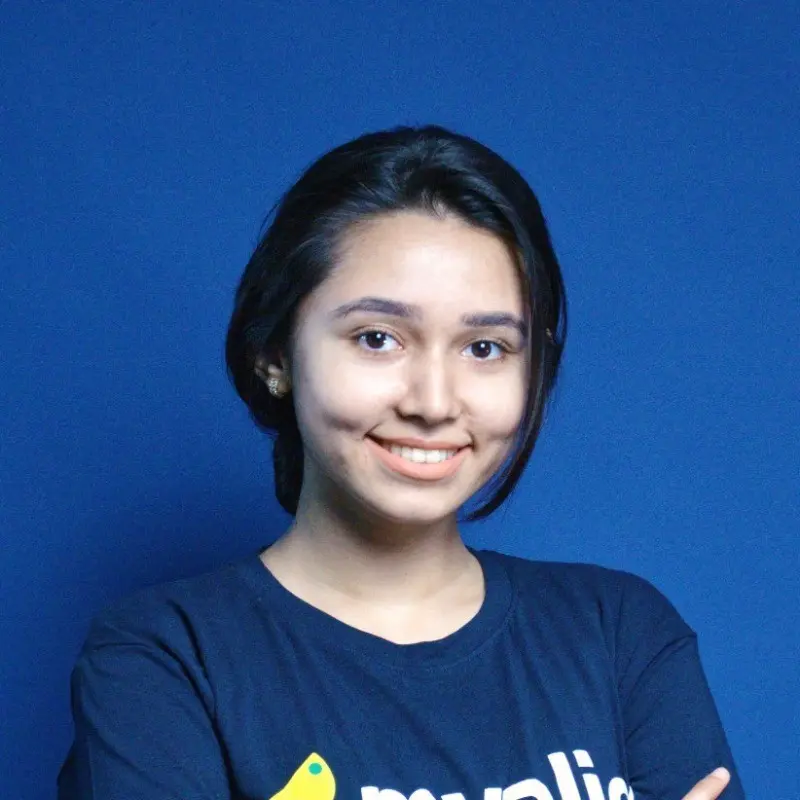What does running a startup look like to you?
When we asked this question to our founder-clients, their answer looked something like this:
Juggling a hundred moving parts such as product development, team building, customer support, fundraising, and of course… growth.
And when we asked them what aspect of growth, the common answer was digital advertising.
It is true that when you’re looking for quick revenue, there’s nothing more effective than advertising. But it isn’t just about throwing money at Facebook or Google and hoping for the best.
Behind every high-performing campaign is a smart, structured process called digital media buying and if you’re not familiar with it yet, you’re in the right place.
This guide is your go-to crash course on how digital media buying actually works, written for startup founders, early teams, and anyone navigating the world of paid ads for the first time.
Here’s what we’ll cover:
- What digital media buying is.
- Why it matters for startups.
- The types of media buying.
- A step-by-step walkthrough of the media buying process.
- The tools, platforms, and skills used by digital media buyers
- Common mistakes to avoid
… and a lot more!
This isn’t a technical manual. It’s a clear, founder-friendly playbook that’ll help you move from “I should probably run ads” to “I know exactly how to approach this.”
What is digital media buying (and why should startups care)?
At its simplest, digital media buying is the process of purchasing online advertising space. That space could be anything from a Google search ad to a YouTube pre-roll, a Facebook carousel, or a banner ad on a tech blog. But it’s not just about choosing a platform and clicking “launch.”
Digital media buying requires you to know where your ideal customers spend time online, figure out how to reach them efficiently, and decide how much to spend to get their attention without blowing your budget.
How is media buying different from media planning?
Good question. The two often go hand-in-hand, but here’s the key distinction:
- Media planning is the strategy. It’s where you decide what channels to use, how much to budget, and who you’re targeting.
- Media buying is the execution. It’s where you actually go out and buy the ad space based on that plan. This includes negotiating, bidding, launching, and optimizing.
Think of media planning as designing the blueprint for your house, and media buying as actually buying the bricks and hiring the crew to build it.
In small teams (especially startups), planning and buying are often done by the same person or partner. But it’s helpful to know the difference so you can ask smarter questions, especially if you work with freelancers or agencies.
Why does digital media buying matter for startups and founders?
When you’re just getting off the ground, every dollar counts. You can’t afford to run messy, unstrategic campaigns that bring in vague vanity metrics but no real results. And yet, digital advertising can also be one of the fastest, most scalable ways to drive growth if done right.
Here's why understanding digital media buying gives you an edge:
- You avoid overspending on channels that won’t move the needle
- You learn faster because your campaigns are intentional and measurable
- You delegate better, whether to a freelancer, agency, or team member
- You stay in control of your growth, instead of guessing what’s working
Most importantly: even if you don’t plan to manage campaigns yourself, you need to know enough to steer the ship. Just like you wouldn’t blindly sign a product roadmap or investor term sheet, you shouldn’t treat your paid media spend as a black box.
The good news is that you don’t need a marketing degree to master this. A solid understanding of the basics can go a long way in helping your startup grow smarter, not just louder.
Types of digital media buying
Not all ad space is bought the same way. Depending on your budget, goals, and how hands-on (or automated) you want your campaigns to be, there are different types of media buying models you’ll want to understand.
Let’s simplify them into two main camps: direct buys and programmatic buying.
1. Direct media buying
This is the old-school (but still relevant) way of buying ad space.
In this case, you, or your media buyer, reach out directly to a publisher — say, TechCrunch, Forbes, or a niche blog, and negotiate a deal. You decide where the ad will appear, how long it’ll run, and how much you’ll pay. It’s like booking a billboard but on the internet.
Pros:
- Full control over placement and context
- Great for brand-safe environments
- Ideal for awareness or sponsorship campaigns
Cons:
- Time-consuming
- Harder to scale
- Usually more expensive per impression
This model is better suited for larger budgets or PR-style campaigns but can work for startups running hyper-targeted niche placements (e.g., sponsoring a Substack newsletter read by your exact ICP aka Ideal Customer Profile).
2. Programmatic media buying
This is where most modern startups focus their media buying efforts.
Programmatic buying is automated, meaning machines handle the bidding, placement, and optimization of ads in real time. It uses platforms like Google DV360, The Trade Desk, or even Meta Ads and Google Ads, which function as demand-side platforms (DSPs).
There are three types of programmatic deals you should know:
| Programmatic Deal Type | How It Works | Best For |
|---|---|---|
| Real-time bidding (RTB) | Open auction model where ads are bid on in real-time whenever a user loads a page or app. The highest bidder wins the placement. | Scale, efficiency, performance-driven campaigns |
| Private marketplace (PMP) | Invite-only auctions where select advertisers bid on premium ad inventory (e.g., top publishers or apps). More exclusive than RTB. | Balancing quality and efficiency |
| Programmatic direct | Fixed-price deals made directly with publishers, executed via programmatic platforms. Combines control of direct buying with automation. | Predictable impressions, brand-safe environments, mid-scale budgets |
Which model should startups use?
If you’re just starting out, RTB (Real-time bidding) via Google Ads or Meta Ads is your best bet. It’s:
- Easy to set up and launch within hours
- Data-rich for fast learning
- Flexible on budget. You can start with as little as $100
As you scale, you might explore PMP (Private marketplace) deals for better placements or even programmatic direct if you’re running high-volume brand awareness campaigns.
The key takeaway is that while you don’t have to know every technical term, you do need to understand how these models affect your reach, spend, and targeting power.
Different pricing models and metrics of digital media buying
When you buy ad space, you're not just paying for a spot. Rather, you're paying for a specific type of result. That result could be an impression, a click, a conversion, or even a return on your entire spend.
Let’s walk through the most common models and metrics you’ll encounter and how to decide which one makes sense for your startup goals.
| Model/Metric | What It Is | When to Use It | Example | Watch Out For |
| CPM (Cost Per Mille) | You pay for every 1,000 times your ad is shown, regardless of clicks. |
|
Running Instagram Story ads to build buzz for a new product launch. | High impressions but low engagement; use frequency caps and fresh creative. |
| CPC (Cost Per Click) | You only pay when someone clicks your ad. |
|
Google Ads targeting “best CRM for startups” to drive site visits. | Irrelevant or curiosity clicks; monitor CTR (Click-through Rate) and bounce rate closely. |
| CPA (Cost Per Acquisition) | You pay only when a user completes a key action, like signing up or purchasing. |
|
DTC brand running Meta ads that only charge when someone makes a purchase. | Needs strong historical data; not ideal for early campaigns with low conversion data. |
| CPL (Cost Per Lead) | You pay when someone submits contact info (e.g., email). |
|
LinkedIn Ads for a startup’s burn rate calculator, gated by email. | Lead quality issues; always validate whether leads are qualified and converting. |
| ROAS (Return on Ad Spend) | A metric that measures revenue generated per dollar spent on ads. |
|
Spend $1,000 on ads, earn $4,000. That’s a 4x ROAS. | Chasing short-term ROAS can limit brand-building; don’t ignore LTV (Life-time Value) or funnel depth. |
So which one is best for a startup?
The truth is you cannot hold onto one model or metric. What you can do is know which one to refer to according to your objective. Here’s a general rule of thumb:
- Use CPM if your goal is awareness
- Use CPC if you want engagement and traffic
- Use CPA/CPL when your funnel is already working and you want efficient growth
- Use ROAS if you have good historical conversion data and your focus is on profitability and return on investment.
Don’t be afraid to start with simpler models (like CPC) and evolve as your campaigns mature.
Digital media buying process: step-by-step
Whether you’re running ads yourself, delegating to a freelancer, or just trying to make sense of what your agency is doing this step-by-step guide will show you how smart media buying really works and how to set your startup up for success from the start.
Let’s dig in:
1. Set clear campaign objectives
Before you even open an ad platform, you need to answer one critical question:
“What’s the single, specific outcome I want from this campaign?”
This outcome could be:
- Website traffic (e.g. drive 5,000 visits to a landing page for your new product)
- Lead generation (e.g. collect 300 demo requests in 30 days)
- Sales (e.g. generate $10,000 in revenue at a 3x ROAS)
- App downloads (e.g. acquire 1,000 installs under $2 CPI)
- Brand awareness (e.g. reach 100,000 people with a frequency of 2+)
Be precise with your expectations and goals. Vague goals like “get more signups” or “run some ads” won’t give you anything to measure or optimize toward. A good goal is quantifiable, time-bound, and tied to your broader business objectives. Also, make sure to write your goal down before you log into any ad platform. Put it at the top of your campaign brief so everyone involved is aligned.
2. Understand your audience inside-out
Digital ads only work when they speak directly to the people you’re trying to reach. That’s why audience clarity is one of the highest-leverage pieces of the puzzle.
Start by defining your ideal customer profile (ICP). For example:
- Are they founders of B2B SaaS startups with <$5M in funding?
- Are they moms in their 30s who shop online for eco-friendly kids’ products?
- Are they IT managers looking for a simpler SOC2 compliance tool?
Then dig deeper into their pain points (what keeps them up at night?), desires (what transformation do they want?), objections (what would stop them from clicking or buying?), and online behavior (what platforms do they use and what content do they engage with?).
3. Choose the right platforms and channels
Every ad platform has its own strengths. And choosing the right one isn’t about what’s trending, it’s about where your audience already spends their time and what stage of the funnel you’re targeting.
Here’s a quick guide:
- Google Search Ads – Great for high-intent leads. You show up when someone is actively searching for what you offer. (e.g. “best bookkeeping software for startups”)
- Meta Ads (Facebook & Instagram) – Excellent for visual storytelling, retargeting, and product discovery. Ideal for B2C and DTC.
- LinkedIn Ads – Best for targeting professionals by job title, company size, or industry. Pricey but powerful for B2B lead gen.
- YouTube Ads – Great for educating and converting via video. Use for top-of-funnel brand awareness or retargeting warm leads.
- Programmatic Platforms (The Trade Desk, DV360) –Used to run ads across thousands of websites and apps with automated bidding, programmatic platforms help startups scale reach, control placement quality, and optimize performance in real time. This makes them ideal for omnichannel campaigns and advanced audience targeting.
If you’re just starting, pick one or two channels max. Get traction there before expanding. Spreading yourself too thin leads to weak signals and a wasted budget.
4. Decide on your budget and media buying model
You don’t need a massive budget to test ads. But you do need to be intentional about how much you’re spending and what you’re paying for.
Let’s say you have a $1,000 test budget. Here’s how to approach it:
- Start with CPC or CPL models so you only pay for actual engagement
- Use 70% of your budget on your primary campaign, and 30% for experiments
- Avoid vanity impressions (CPM) unless brand awareness is your goal
If your goal is lead generation, you might explain this way to your media buyer or write your own brief:
“I want to get 100 qualified leads at $10 CPL over 3 weeks. I’ll run a LinkedIn campaign targeting VP-level marketers and optimize for lead form completions.”
5. Develop strong ad creatives
Your creative is what people actually see. It’s your first impression, your hook, your pitch, all in one. And it often makes or breaks a campaign.
Here’s what good creative does:
- Captures attention instantly (use contrast, motion, or emotional triggers)
- Communicates value clearly (why should they care?)
- Drives action (what should they do next?)
Match your creative to your platform. A native Instagram Story ad should feel different than a LinkedIn lead gen card.
You can also test multiple creative angles, not just formats. For example:
- “Save time” vs “Cut costs” vs “Avoid stress”
- Pain-driven vs aspiration-driven messaging
- Testimonials vs benefits vs urgency CTAs
Then track which angle converts best. That’s your real insight.
6. Purchase and place your media
This is where the buying happens. You log into your chosen ad platform, set up your campaign, and press “go.” But don’t rush it.
Here’s what to configure:
- Audience targeting (interests, lookalikes, behaviors, custom lists)
- Budget and bidding strategy (manual vs automatic, daily vs lifetime)
- Placements (e.g. feed, stories, search, display network)
- Creative formats (images, videos, carousels, lead forms)
Make sure you also configure, UTM parameters for tracking, Pixel or conversion tracking (e.g. Meta Pixel, GA4 aka Google Analytics, LinkedIn Insight Tag), and attribution windows (e.g. 1-day click vs 7-day view).
It is always a good practice to test campaigns with a small audience or limited spend first. Monitor for 3–5 days before scaling.
7. Track performance and run structured experiments
Once your campaigns are live, your job isn’t done. In fact, this is where the fun begins: tracking and optimization.
Here are the key metrics to monitor:
- Impressions – Are you reaching enough people?
- CTR (Click-through rate) – Are people engaging with your ad?
- CPC/CPL – Are you paying an efficient price for clicks or leads?
- Conversion rate – Is your landing page or funnel doing its job?
- Frequency – Are people seeing your ad too often?
But don’t just passively observe. Set up experiments. You could run an A/B test with different creatives or copy. Or, you can compare two target audiences. Some other ideas for experimenting include shifting the budget between platforms or formats, introducing new offers or CTAs, etc.
8. Measure results and attribute what worked
At the end of your campaign, take some time to pause and reflect. Ask yourself:
- Did you hit your original goal?
- Which creatives performed best?
- What audiences converted the highest?
- Which channels gave the best return?
Look beyond clicks. Track down-funnel outcomes like sales, demo bookings, or onboarding completions. If your CRM or analytics setup can connect these dots, you’ll unlock way better insight than just dashboard metrics.
We also recommend a simple post-campaign report with key metrics, wins and losses, learnings, and next steps.
This gives you a feedback loop for your next campaign and helps you build a repeatable, scalable growth engine.
When you break media buying down like this, it becomes methodical. You don’t need to get every step perfect out of the gate, but having a clear, repeatable process is what separates wasted spend from compounding returns.
Tools and platforms digital media buyers use
When it comes to digital media buying, your tools are your engine. But you don’t need a complex tech stack. You just need the right tools that fit your goals, your budget, and your team’s capacity.
Let’s break down the core platforms, the types of ads you can run on each, and when to use them.
1. Ad platforms (where your ads actually run)
These platforms are where you buy and manage media. Each has unique strengths, targeting options, and ad formats that suit different goals.
Google Ads
Google Ads gives you access to users actively searching for solutions, making it one of the most powerful platforms for capturing high-intent leads through search, display, and video placements.
Best for:
- Capturing high-intent leads through search
- Running targeted retargeting and awareness campaigns on display
- Reaching video viewers through YouTube
Ad formats you can run:
- Search Ads – Text-based ads shown on search engine results pages (SERPs)
- Display Ads – Static or responsive banners shown across millions of websites
- Shopping Ads – Product-focused ads shown on Google Shopping
- YouTube Ads – Pre-roll or in-stream videos (via YouTube integration)
- App Campaigns – Promote mobile apps across search, YouTube, and Play Store
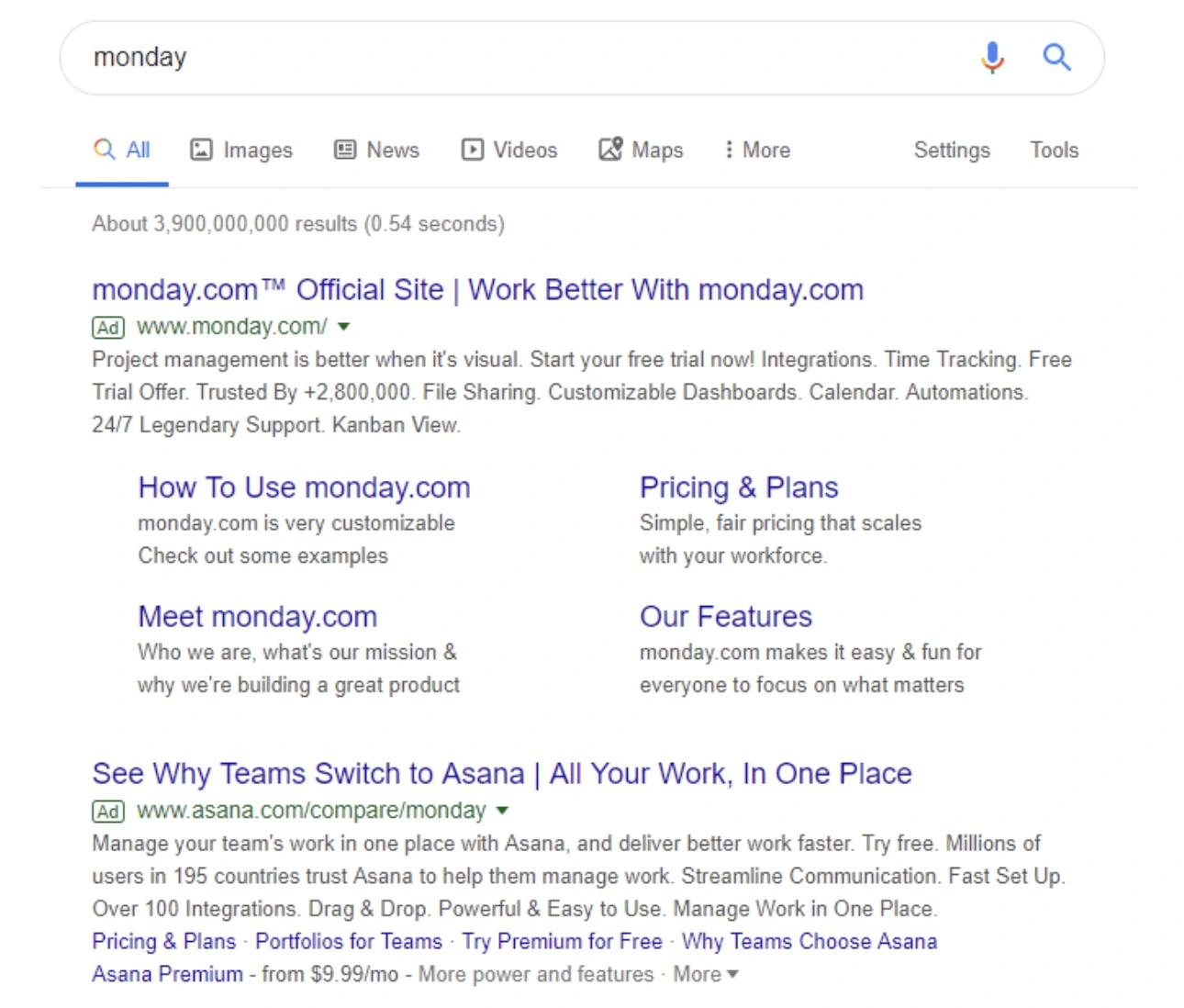
Example of a Google Search Ad
Meta Ads (Facebook & Instagram)
Meta Ads are built for visual storytelling, interest-based targeting, and full-funnel campaigns. These platforms are perfect for driving awareness, engagement, and conversions across B2C and DTC audiences.
Best for:
- DTC and ecommerce startups
- Retargeting website visitors or social engagers
- Creative testing with various formats
Ad formats you can run:
- Feed Ads – Image or video ads in Facebook/Instagram feeds
- Story Ads – Full-screen vertical ads (15 sec)
- Carousel Ads – Swipeable, multi-card formats great for product showcases
- Reels Ads – Vertical video ads placed in short-form video feeds
- Lead Ads – In-app forms to collect signups or inquiries
- Collection Ads – Product-led format that opens a mobile storefront
- Partnership Ads – Instagram-specific ads created with collaborated content
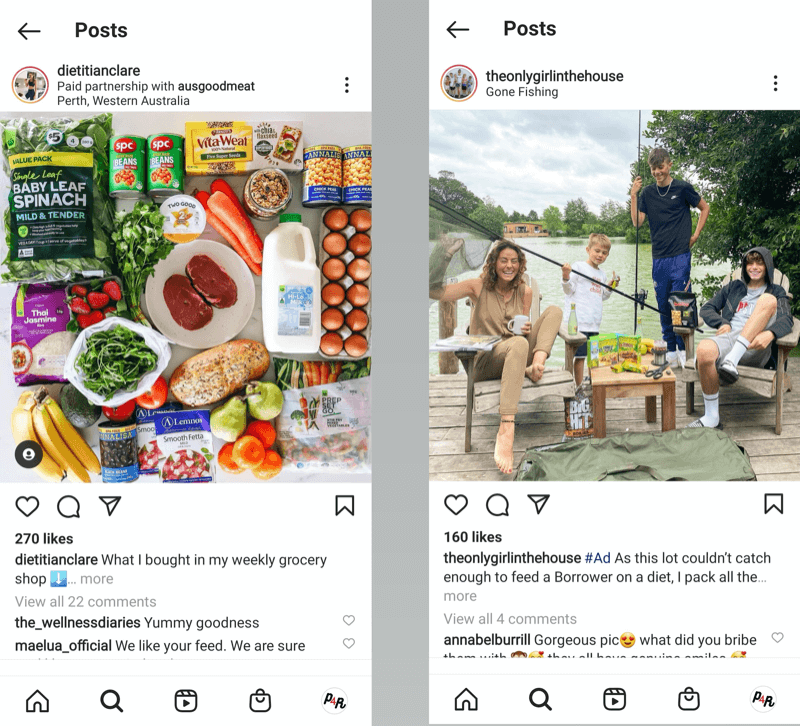
Example of an Instagram Partnership Ad
LinkedIn Ads
LinkedIn offers unmatched B2B targeting by job title, company size, and industry. It is the go-to platform for startups selling to professionals, decision-makers, and niche enterprise segments.
Best for:
- B2B SaaS lead gen
- ABM (Account-Based Marketing)
- Whitepaper or webinar promotions
Ad formats you can run:
- Sponsored Content – Image, video, or carousel posts promoted in the feed
- Message Ads – Inbox messages sent directly to targeted users
- Lead Gen Forms – In-feed ads with native, pre-filled LinkedIn forms
- Text Ads – Small sidebar text-only ads (great for budget efficiency)
- Dynamic Ads – Auto-personalized creative (e.g., using a person’s profile picture)
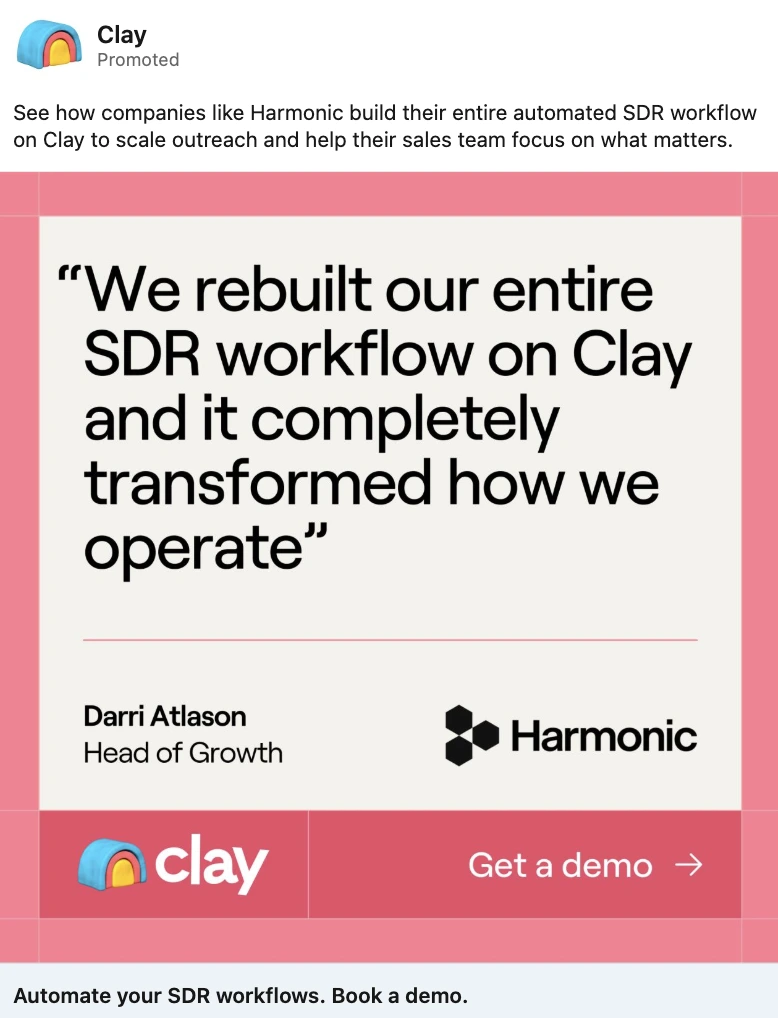
Example of a LinkedIn Ad
YouTube Ads (via Google Ads)
YouTube combines the scale of Google with the emotional power of video. This platform is ideal for educating cold audiences, telling your brand story, and retargeting warm prospects through pre-roll and in-stream formats.
Best for:
- Awareness and education
- Retargeting warm audiences with storytelling
- Brand building for visual-first products
Ad formats you can run:
- Skippable In-Stream Ads (TrueView) – Plays before or during videos, skippable after 5 seconds
- Non-Skippable In-Stream Ads – Short 15s ads that viewers must watch
- Bumper Ads – 6-second non-skippable spots
- In-Feed Video Ads – Appear next to search results or related videos
- Masthead Ads – Premium homepage placement (budget-intensive)
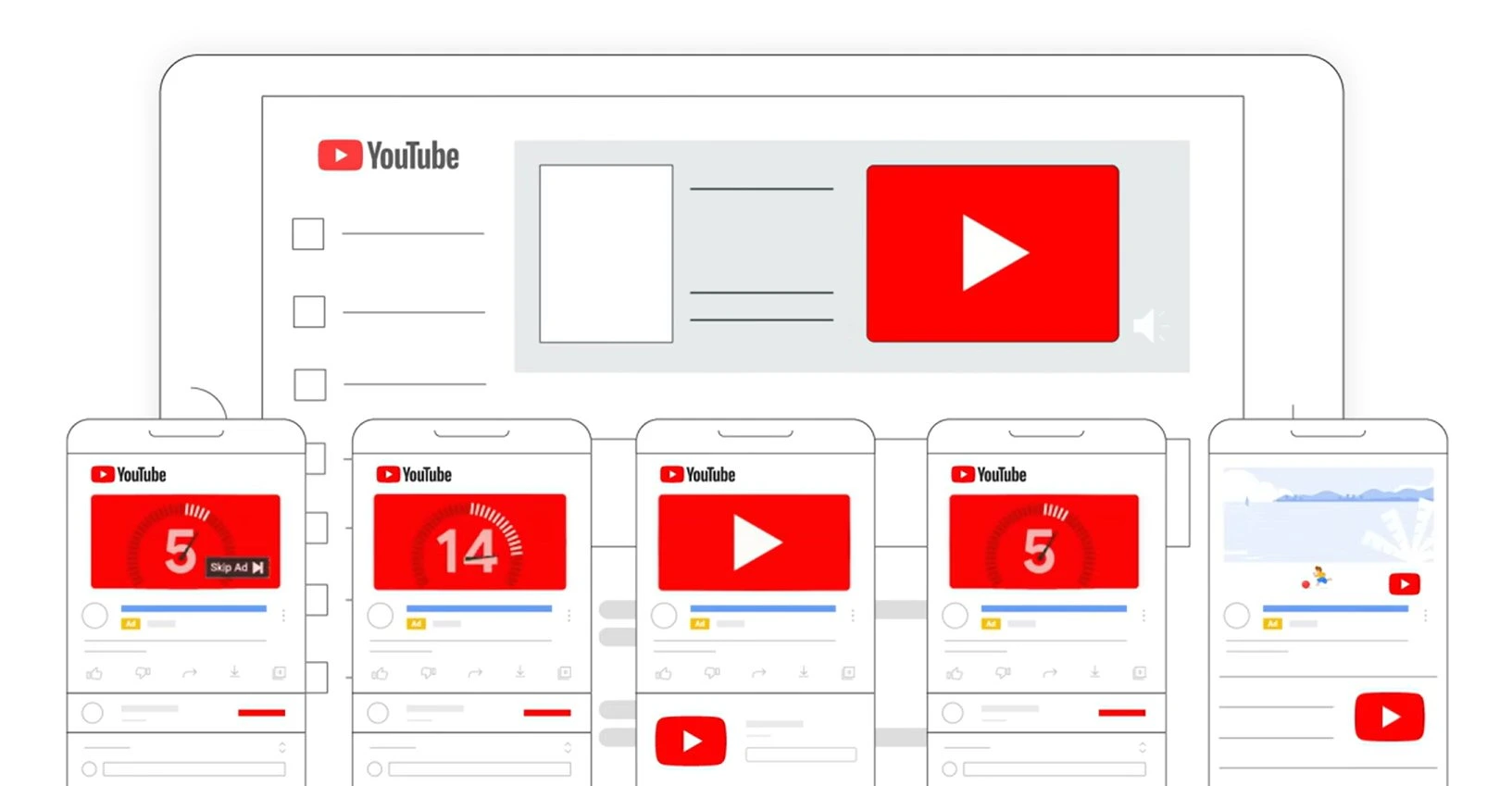
Different formats of YouTube Ad
TikTok Ads
TikTok excels at attention-grabbing, UGC (User generated content)-style content and rapid creative testing — making it a strong channel for DTC brands, lifestyle products, and early adopters across younger or trend-savvy demographics.
Best for:
- DTC brands
- App launches
- Rapid creative testing with viral potential
Ad formats you can run:
- In-Feed Video Ads – Appear between organic TikToks, usually 9–15 seconds
- Spark Ads – Boosted posts from creators (includes their engagement history)
- TopView Ads – Full-screen takeover when app opens
- Branded Hashtag Challenges – Campaigns encouraging users to create content
- Branded Effects – Custom AR filters and effects
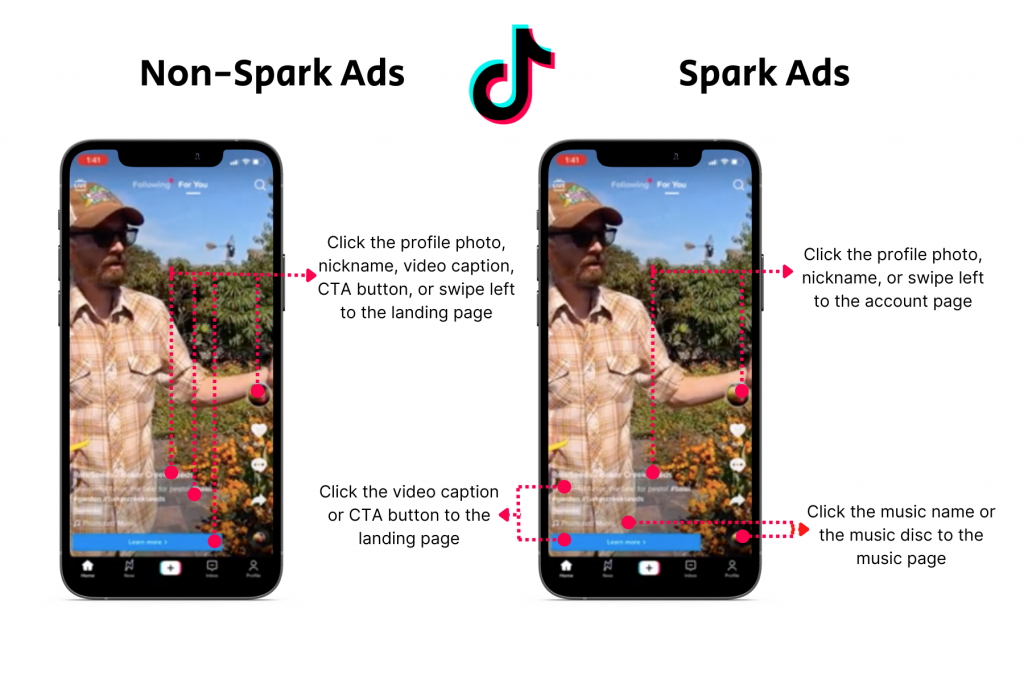
Differences between TikTok's Spark and Non-Spark Ads
Programmatic Platforms (for advanced buyers)
Programmatic platforms like The Trade Desk and DV360 let you run ads across thousands of websites and apps using real-time bidding. This is ideal for startups looking to scale reach, control placement quality, or enter omnichannel territory.
Here are some popular tools for programmatic ads:
- The Trade Desk
- Google DV360
- StackAdapt
- Adroll
Best for:
- Mid- to late-stage startups
- Companies spending $10K+/month
- Cross-channel, multi-format campaigns with complex targeting
Ad formats you can run:
- Display Ads – Across premium websites
- Video Ads – Pre-roll or native placements
- CTV Ads – Connected TV (streaming ads)
- Native Ads – In-feed content that matches the platform’s design
What to look for when hiring a digital media buyer
Hiring a media buyer isn’t just about finding someone who knows how to launch a Facebook campaign. You want someone who can own your ad performance — someone who treats your budget like their own moves fast, and has the instincts of both a strategist and an operator.
Here’s exactly what to look for when hiring a digital media buyer, whether it’s your first freelancer, a contractor, or an in-house hire.
1. Platform expertise
The first thing to assess is whether the media buyer has hands-on experience with the platforms your campaigns will run on. They should be fluent in managing Google Search and Display campaigns, capable of running creative tests on Meta Ads (Facebook and Instagram), and comfortable using LinkedIn’s lead generation tools if you're in B2B. They should understand the nuances of bidding strategies like CPC vs. manual bidding, and be able to navigate attribution across platforms, not just rely on whatever the platform’s dashboard says. This kind of technical fluency is non-negotiable if you want your spend to drive results.
2. Strategic thinking
Great media buyers should be able to look at your business goals and recommend which channels make the most sense, how to sequence cold and warm audiences across the funnel, what creative hooks will resonate with different segments, and how your budget should be distributed across awareness, consideration, and conversion. It’s not just about tactics; it’s about knowing why a certain approach works and being able to explain the tradeoffs clearly.
3. Creative collaboration skills
Even if they’re not designing the ads themselves, media buyers need a strong eye for what makes creative work. They should know what high-performing ad formats look like across platforms, be able to brief a designer or content creator clearly, recognize early signs of creative fatigue, and suggest strong creative angles — whether it’s a bold hook, a better CTA, or a more relevant visual. The best buyers bring creative intuition that’s shaped by pattern recognition across hundreds of campaigns.
4. Data-driven mindset
You want someone who sees numbers not just as data, but as signals. A solid media buyer should be fluent in key performance metrics like CTR, CPL, ROAS, frequency, and conversion rates. They need to interpret platform dashboards in context, validate results through tools like GA4 or your CRM, and design structured tests that lead to meaningful insights. Most importantly, they should be able to look at performance data and turn it into clear recommendations for what to do next.
5. Clear communication and reporting
Communication makes or breaks your working relationship, especially if you’re not in the ad accounts every day. A great media buyer will proactively share performance updates, flag wins or issues before you even ask, and deliver reports that are easy to digest and focused on what matters. They’ll explain their decisions and results in clear, straightforward language, not jargon, so you always know where your budget is going and what’s being tested.
6. Adaptability and ownership
Startup environments move fast and your media buyer needs to keep up. They should be able to pivot quickly if a campaign flops suggest new experiments on their own, and take full ownership of results. The best buyers act like growth partners: they don’t wait for instructions, they solve problems proactively, and they treat your budget with the same care and urgency as if it were their own.
7. Proof of results
It’s one thing to talk a good game, it’s another to show outcomes. Ask your media buyer to share actual performance snapshots from past campaigns. Look for before-and-after metrics, clear contributions to real business goals (not just vanity numbers), and details on what kinds of budgets and company stages they’ve worked with. You’re looking for someone who knows how to win and can prove it.
8. Cultural fit and mindset
Especially in early-stage startups, skill alone isn’t enough. Your media buyer needs to click on how you work. Look for someone entrepreneurial, self-motivated, and comfortable operating with lean resources. They should be collaborative, open to feedback, and energized by the idea of experimenting, iterating, and helping you grow faster. You’re not hiring a vendor. But you’re bringing on a partner in growth.
Hiring a media buyer is one of the most impactful growth hires you can make. But only if you bring on someone who thinks like a partner, not just a technician.
How to become a digital media buyer
If you're thinking about learning media buying yourself, or training someone in-house, the path is surprisingly accessible. Start by getting hands-on with platforms like Google Ads and Meta Ads using small budgets to run real campaigns. Supplement that with free certifications (like Google Skillshop or Meta Blueprint), and study performance breakdowns from top advertisers. Focus on understanding audience psychology, testing creative angles, and reading campaign data with a problem-solving mindset. The best media buyers are curious, adaptable, and relentless about turning budgets into results.
Should startups hire a media buyer or go DIY (Do it Yourself)?
This is one of the most common questions founders face when they start exploring paid ads: “Do I run campaigns myself or bring in someone to help?”
Here’s the honest answer: it depends on your stage, your time, and your risk tolerance.
If you’re in the early days, running lean, and just testing whether paid channels can work, there’s real value in doing it yourself. This is for at least the first few campaigns. It gives you firsthand insight into what your audience responds to, how platforms work, and where your messaging breaks down. You don’t need to be perfect, you just need to learn fast.
But media buying gets complex quickly. As soon as you’re managing multiple campaigns, testing creatives, adjusting bids, tracking ROAS across platforms, or spending $2K+/month, the DIY route can become expensive in the form of missed optimization or simply time you don’t have.
So here’s a rule of thumb:
| Situation | Recommendation |
|---|---|
| Spending < $1K/month | DIY or consult a friend/freelancer for setup |
| Spending $1K–$5K/month | Hire a freelancer part-time or a small paid media agency |
| Spending $5K–$10K/month | Dedicated freelancer or part-time in-house media buyer |
| Spending $10K+/month | Consider a full-time hire or performance agency with deep platform expertise |
Think of it this way:
- Go DIY if you’re testing and learning
- Go freelancer or agency when you want better efficiency and faster iterations
- Go in-house when paid media becomes a core growth engine that requires full ownership
Whatever path you choose, the key is staying close to performance. Even if you’re not running the campaigns yourself, you should always know what platforms you’re on, how much you’re spending, what results you’re getting, and what’s being tested next.
Common mistakes in digital media buying (and how to avoid them)
Digital ads can unlock explosive growth or quietly drain your budget if not handled carefully. Most of the time, it’s not bad luck or algorithm changes; it’s just avoidable mistakes made early on. Below are the biggest traps startup founders fall into when running paid campaigns and how you can navigate around them with confidence.
1. Running ads without a clear goal
One of the most damaging and common mistakes is launching a campaign without a specific, measurable outcome. When the objective is vague (“get more traffic” or “build awareness”), it becomes impossible to measure success, optimize performance, or make strategic decisions.
Without a goal, everything feels random: budgets fluctuate, targeting becomes guesswork, and reporting is just a mess of numbers without meaning.
What to do instead:
Before you touch an ad platform, define exactly what you want out of the campaign. Are you trying to collect 200 emails at a $5 CPL? Book 20 demos this month? Drive 1,000 qualified site visits? The more specific your goal, the easier it is to shape targeting, budget, creative, and optimization strategies around it.
2. Targeting too broadly
It’s tempting to cast a wide net, especially when you’re still figuring out who your best customers are. But general targeting usually means you're spending money to reach people who may never convert. Worse, your ad creative ends up watered down in an attempt to appeal to everyone and ends up resonating with no one.
What to do instead:
Start narrow. Build out specific audiences, even if they’re small, based on your ideal customer profile. Use criteria like job titles, behaviors, or lookalikes. It’s better to reach 1,000 people who are 90% likely to convert than 10,000 who don’t care. You can always scale targeting later once you know what works.
3. Underestimating the power of creative
Founders often focus so much on targeting and budgeting that they treat creative like an afterthought. But your ad is your first impression. A weak headline, generic visual, or unclear value prop can crush your CTR, no matter how great your targeting is.
Remember: users aren’t looking for your ad. You have seconds to earn attention. Your creative is what stops the scroll and sparks interest.
What to do instead:
Invest in strong creative. Start with 2–3 concepts based on real user pain points, and test different angles such as emotional, aspirational, direct. Use clean visuals, punchy headlines, and clear calls to action. Monitor engagement, and refresh ads every 1–2 weeks to prevent fatigue.
4. Killing campaigns too quickly
A lot of startup teams panic when a campaign doesn’t show results in the first 24–48 hours. They pause it too early, thinking it’s a failure. But most ad platforms, especially Meta and Google need a few days to optimize delivery, collect data, and find the right users. Without that runway, you’re not testing ads, you’re just dabbling.
What to do instead:
Let your campaigns run long enough to generate statistically significant data. That usually means at least 5,000–10,000 impressions or at least one week of delivery. Even if results aren’t perfect, early performance gives you a signal to adjust and improve. This is the whole point of testing.
5. Relying only on platform metrics
Google and Meta want you to believe their ads are driving all your conversions — and sometimes, they overstate it. Relying only on platform dashboards can lead to misattribution, inflated ROAS, and over-optimizing channels that may not actually be performing as well as they seem.
What to do instead:
Use independent tracking wherever possible. Set up Google Analytics 4 (GA4), use UTMs on every link, and track actual behavior on your site or app. If you can, build a lightweight attribution model that pulls in CRM data, LTV, or even post-purchase surveys. That way, you’re basing decisions on reality, not just what ad platforms claim.
6. Random testing without structure
You’ve probably heard that you should “test everything” in paid ads. But testing without a plan just leads to noise. If you change your creative, your audience, your landing page, and your CTA all at once, how will you know what made the difference?
What to do instead:
Run structured A/B tests, changing one variable at a time. For example: run the same creative to two different audiences. Or test two headlines with identical visuals. Track each variation carefully, name your campaigns clearly, and analyze performance weekly.
7. Neglecting retargeting
Many startups put all their budget into reaching new people and forget about the warm leads who already visited their site, watched their video, or clicked on an ad. These people are often way more likely to convert, but without retargeting, they slip through the cracks.
What to do instead:
Set up retargeting campaigns from Day 1, even with a small budget. Target website visitors, cart abandoners, video viewers, or email subscribers. Use different messaging than cold ads. Highlight urgency, testimonials, or offer reminders. Often, these are the campaigns with the highest ROI per dollar spent.
Avoiding these mistakes will accelerate your learning curve and build a more sustainable paid growth engine. Paid media is a muscle. And like any muscle, it gets stronger the more you train it, but only if you’re lifting with good form.
FAQ
What is digital media buying?
What is a digital media buying agency?
What is an example of media buying?
What does a digital media buyer do?
Is media buying part of digital marketing?
What’s the difference between media buying and media planning?
Wrapping up
Digital media buying can feel intimidating at first.
Especially when you’re juggling product, hiring, customer feedback, and five other priorities.
But as this guide shows, it's not about mastering every ad platform overnight. It’s about understanding the fundamentals: who you’re targeting, what message you’re leading with, and how to learn quickly from every dollar spent.
Done right, media buying becomes more than a traffic channel. It becomes a feedback loop. A growth engine. A way to test, scale, and validate your value prop in real time.
That said, doing it well takes time, attention, and a lot of iteration. If you don’t have an in-house team yet, or you’re operating with limited time or expertise, running media buying yourself can end up being more expensive than you think in wasted budget and missed opportunities.
In that case, the smartest move is to delegate it to a performance-focused agency. The right partner will treat your spend like their own, help you avoid costly mistakes, and turn paid media into a repeatable, profitable growth channel. So you can focus on building the business.
Because at the end of the day, it's not about knowing every ad setting. It's about knowing when to ask for help, and who to trust with your runway.
